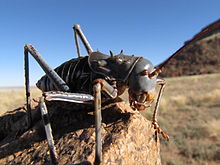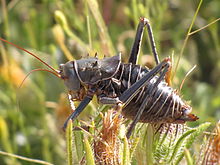- Acanthoplus discoidalis
-
Acanthoplus discoidalis Scientific classification Kingdom: Animalia Phylum: Arthropoda Class: Insecta Order: Orthoptera Superfamily: Tettigonioidea Family: Tettigoniidae Genus: Acanthoplus Species: A. discoidalis Binomial name Acanthoplus discoidalis
Walker, 1869Acanthoplus discoidalis (armoured ground cricket, armoured bush cricket, corn cricket or koringkrieke) is a species of katydid that is native to Namibia, Botswana, and South Africa. They are wide-bodied, flightless and can grow to around 5 cm. Their thorax is covered in sharp spines and they have a pair of strong biting jaws. They are able to defend themselves against predators in an unusual manner by squirting haemolymph (insect blood) out of their bodies.[1] Their populations peak in autumn and their bodies often litter roads during this time. When deprived of protein and salt they can become cannibalistic.[2]
Contents
Diet
Acanthoplus discoidalis are omnivorous and will eat many different foods. One record documented them attacking Red-billed Quelea nestlings. It is believed that they may be able to detect the location of nests using auditory signals.[3]
Defense
Acanthoplus discoidalis have several defensive mechanisms that they use when attacked, as well as the innate defence provided by their armoured exoskeleton. The mechanism used depends on the sex of the individual and the method of attack. When attacked from the side, males will stridulate and both sexes will attempt to bite the attacker. In around 50% of attacks from the side, both sexes will autohaemorrhage, squirting between 5 mg and 80 mg of toxic haemolymph at their attacker over distances up to 30 cm. When attacked from above and therefore less able to bite their attacker they autohaemorrhage more than when attacked from the side. Experiments have shown that the haemolymph is distasteful to at least two reptile species, but the compounds that confer this are unknown. It has been hypothesised that they may be phytotoxins found in plants that the crickets eat and that they then sequester these to use as defensive compounds themselves. After autohaemorrhaging they clean themselves meticulously, this is thought to be done so that other members of the species do not cannibalise them. Bateman and Fleming, experts on the species, believe that autohaemorrhage is a carefully regulated defence response rather than an accidental consequence of being attacked. Another defensive response is to regurgitate their stomach contents when attacked, this is used more often when the insect has already been attacked repeatedly.[2]
Reproduction
Acanthoplus discoidalis have a relatively long courtship period, it starts at sunset and is usually completed by sunrise.[4] Males stridulate which attracts females to their location.[2] Males produce a large sperm pouch and an associated spermatophylax (a body of food given to the female as a nuptial gift) - together termed the spermatophore. They therefore cannot mate again for some time as they have to wait until a new spermatophore has grown. Females mate once before laying eggs, and then mate and lay eggs in a random order. This means that it is advantageous for males to mate with virgins over non-virgins as a higher proportion of the offspring will be their own. Males are able to discriminate between virgins and non-virgins and successfully complete more matings with virgins and they transfer their spermatophore more quickly when mating with virgins. Virgins are lighter than non-virgins allowing males to distinguish between virgins and non-virgins by determining the mass of the female when they copulate.[4]
Control
Acanthoplus discoidalis is a pest of sorghum and millet in Southern Africa and can cause decreases in yield of up to 40% in these crops in some years. Insecticides can be used, but as Acanthoplus discoidalis are flightless they can be controlled fairly easily by constructing a 50 cm deep trench around the field, poisoned baits can also be placed in the trenches. It has been suggested that the crickets could also be used as high protein chicken feed.[5]
References
- ^ Walker, Matt (28 July 2009). "Insect defence all blood and guts". BBC Earth News. http://news.bbc.co.uk/earth/hi/earth_news/newsid_8172000/8172168.stm. Retrieved August 7, 2009.
- ^ a b c Bateman, Philip; P. A. Fleming (28 Apr 2009). "There will be blood: autohaemorrhage behaviour as part of the defence repertoire of an insect". Journal of Zoology 278 (4): 342–348. doi:10.1111/j.1469-7998.2009.00582.x. ISSN 1469-7998. http://www3.interscience.wiley.com/journal/122368498/abstract. Retrieved August 7, 2009.
- ^ Cheke, Robert; Peter Jones, Martin Dallimer and Stuart Green (2003,). "Armoured Bush Cricket attacks on nestling Red-billed Quelea (Quelea quelea)". Ostrich (NISC Pty Ltd) 74 (1 and 2): 135. ISSN 0030–6525. http://www.nri.org/quelea/Papers/Cheke-ABC-Q.pdf. Retrieved August 7, 2009.
- ^ a b Bateman, Philip; J. W. H. Ferguson (2004). "Male mate choice in the Botswana armoured ground cricket Acanthoplus discoidalis (Orthoptera: Tettigoniidae; Hetrodinae). Can, and how, do males judge female mating history?". Journal of Zoology (The Zoological Society of London) 262 (3): 305–309. doi:10.1017/S0952836903004679. http://journals.cambridge.org/production/action/cjoGetFulltext?fulltextid=204760. Retrieved August 7, 2009.
- ^ Green, Stuart; John Holt, L Mazhani, Jannette Mitchell, Pharoah Mosopi, Patrick Mviha, Clark Scholtz, Johny Van der Berg, L Wadhams. "Trench warfare to combat crickets in southern Africa Control of Armoured Bush Cricket in southern Africa". http://www.researchintouse.com/nrk/RIUinfo/PF/CPP68.htm. Retrieved August 7, 2009.
External links
Categories:- Tettigoniidae
- Animals described in 1869
- Orthoptera of Africa
Wikimedia Foundation. 2010.


